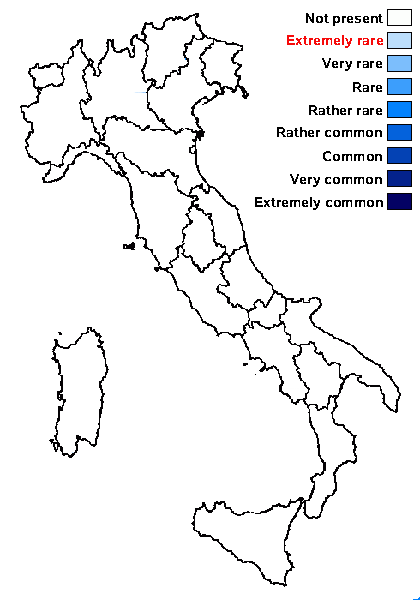Lambiella mullensis (Stirt.) Fryday & Coppins
in Cannon & al., Revisions of British and Irish Lichens, 17: 9, 2021. Basionym: Lecidea mullensis Stirt. - Scottish Natural., 4: 166, 1878
Synonyms: Lecidea scabridisca V. Wirth; Rimularia mullensis (Stirt.) Coppins
Distribution:
Description: Thallus crustose, episubstratic, grey-brown to brown, of convex to tuberculate clusters of areoles, delimited by a black prothallus. Medulla white, I-. Apothecia lecideine, black, round to angular or even contorted and slit-like by mutual compression, (0.2-)0.3-0.5 mm across, immersed, with a concave to flat, subgyrose to umbonate disc, and a thin, slightly raised, persistent proper margin. Proper exciple thin, dark brown, K-; epithecium orange-brown to dark reddish brown; hymenium colourless, 70-100 (-110) μm high, I+ blue turning partly red; paraphyses richly branched and anastomosing, 1.5-2.3 μm thick, more or less moniliform in upper part, the apical cells up to 4.5 μm wide, brown-capped; hypothecium brownish to deep reddish brown. Asci 8-spored, broadly clavate, with a K/I+ blue tholus with a funnel-shaped central unstained region, and a small, obconical, apical K/I+ blue dome, Lambiella-type. Ascospores 1-celled, hyaline, broadly ellipsoid to subglobose, (6-)8-11(-12.5) x (4-)5-7(-7.5) μm. Photobiont chlorococcoid. Spot tests: thallus, especially medulla, K+ yellow turning red (needle-like crystals), C-, KC-, P+ yellow-orange. Chemistry: norstictic acid.Note: on acid, hard siliceous rocks in wind-exposed sites, mostly in boulder screes of the subalpine belt. Known from the Eastern Alps (Austria); to be looked for in the Italian Alps.
Growth form: Crustose
Substrata: rocks
Photobiont: green algae other than Trentepohlia
Reproductive strategy: mainly sexual

Predictive model
Growth form: Crustose
Substrata: rocks
Photobiont: green algae other than Trentepohlia
Reproductive strategy: mainly sexual

Predictive model
 Index Fungorum
Index Fungorum
 GBIF
GBIF

